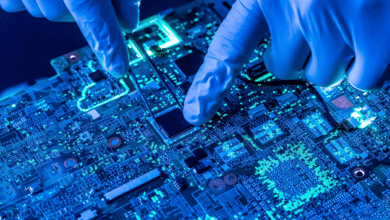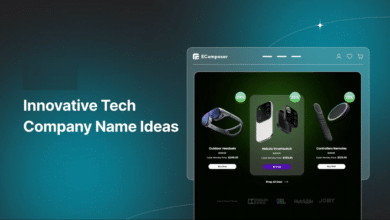The Latest Technology: Trends, Innovations, and What’s Next in 2025

In a rapidly evolving world, staying informed about the latest technology is crucial for individuals and businesses alike. From artificial intelligence (AI) and 5G to quantum computing and augmented reality (AR), technology is advancing at an unprecedented pace. This article will delve into some of the most exciting innovations in 2025, explore the trends shaping the future, and highlight the importance of embracing technological advancements.
Technology has always played a pivotal role in shaping society. In 2025, it continues to transform our daily lives, work, and entertainment in ways that were once unimaginable. Whether it’s the integration of AI into everyday devices or breakthroughs in medical technology, the latest trends are pushing the boundaries of what we can achieve. This article will explore these developments, providing insight into how they’re changing the world.
Key Areas of Technological Advancement in 2025
1. Artificial Intelligence (AI) and Machine Learning
AI and machine learning (ML) are not new concepts, but their capabilities have dramatically expanded in recent years. In 2025, AI has become more integrated into our daily lives, from self-driving cars to personalized healthcare solutions. Companies across various industries are adopting AI to streamline operations, enhance customer experiences, and innovate products and services.
Trends in AI and ML
- Generative AI: This is a new frontier in AI development, where algorithms generate content such as text, images, and even music. OpenAI’s GPT-3 and other generative models have laid the foundation for this technology. In the near future, generative AI may extend to creating films, designing products, and writing code autonomously.
- AI in Healthcare: Machine learning algorithms can now analyze medical data to help diagnose diseases, predict patient outcomes, and suggest personalized treatments. For example, AI-driven diagnostic tools are already being used to detect cancers and predict heart disease with a higher degree of accuracy than traditional methods.
- Automation of Workplaces: AI-powered automation is streamlining business operations, reducing costs, and improving efficiency across sectors like manufacturing, logistics, and customer service. Companies are using AI-driven chatbots and virtual assistants to handle customer queries, saving time and resources.
Real-World Impact of AI and ML
AI and ML are transforming industries by automating repetitive tasks, analyzing large datasets, and offering smarter, more efficient solutions. Healthcare, finance, and even education are experiencing substantial shifts due to these technologies. For instance, AI-powered telemedicine tools allow healthcare providers to offer virtual consultations with accurate diagnostic tools, which makes healthcare more accessible to people in remote areas.
2. 5G Technology

5G is the next generation of mobile networks, offering faster speeds, lower latency, and more reliable connections. As of 2025, 5G is already being rolled out in many parts of the world, with a significant impact on both consumers and industries. This technology not only improves connectivity for individuals but also supports the growth of various industries that rely on rapid data exchange and seamless communication.
Benefits of 5G
- Faster Speeds: 5G enables download speeds up to 100 times faster than 4G, making activities like streaming, gaming, and downloading data more efficient. For example, 5G networks will allow users to stream 8K video without buffering or delays.
- Low Latency: The reduced latency of 5G networks enhances real-time communication, making it ideal for applications like autonomous driving, telemedicine, and online gaming. In critical applications like remote surgery, low latency is essential for accurate and real-time interaction between the doctor and robotic instruments.
- IoT Growth: 5G supports the massive number of connected devices that make up the Internet of Things (IoT), allowing for smarter homes, cities, and industries.
Impact of 5G Across Industries
5G will enable new technologies and services, such as augmented reality (AR) and virtual reality (VR), to be used in real-time, providing immersive experiences. In manufacturing, 5G will facilitate real-time tracking of inventory, enabling supply chains to be more efficient and responsive. The automotive industry, too, will benefit from 5G through the deployment of connected vehicles that can communicate with each other and traffic infrastructure to improve safety and reduce accidents.
3. Internet of Things (IoT)
The Internet of Things (IoT) refers to the network of connected devices that communicate with each other through the internet. By 2025, IoT devices are expected to become more sophisticated, enabling smarter and more efficient homes, cities, and industries. The growth of IoT is linked to the expansion of 5G networks, which provide the necessary bandwidth and low latency for these devices to operate seamlessly.
How IoT is Changing Our World
- Smart Homes: Devices like smart thermostats, security cameras, and voice assistants are becoming standard in homes, allowing homeowners to control and monitor their environment remotely. The integration of AI with IoT devices also allows for predictive behavior. For instance, a smart thermostat can learn your schedule and adjust the temperature accordingly, improving energy efficiency.
- Healthcare: IoT devices such as wearables can track vital signs and alert healthcare providers to potential issues in real time, improving patient care. Smartwatches that monitor heart rate, oxygen levels, and even blood sugar are already providing valuable insights to doctors and patients alike.
- Industrial IoT (IIoT): In manufacturing, IoT sensors monitor equipment performance, reducing downtime and improving productivity. IoT-enabled predictive maintenance tools allow companies to identify when machinery needs servicing before it breaks down, preventing costly repairs and operational disruptions.
Example of IoT in Action
Smart cities are a growing trend where IoT devices are integrated to improve urban living. In some cities, smart traffic lights adjust the flow of traffic based on real-time conditions, while sensors in garbage bins signal when they are full, optimizing waste collection routes. These IoT-enabled systems make cities more efficient and sustainable.
4. Quantum Computing
Quantum computing represents a significant leap forward in computational power. Unlike classical computers that use bits to process information, quantum computers use qubits, allowing them to solve complex problems at a speed unimaginable for traditional machines. While still in the experimental stages, quantum computing is poised to revolutionize fields such as cryptography, drug discovery, and optimization.
Applications of Quantum Computing
- Cryptography: Quantum computing is poised to break current encryption methods, leading to the development of more secure communication protocols. Quantum encryption algorithms, such as quantum key distribution (QKD), will help ensure data privacy in an age where data breaches are increasingly common.
- Drug Discovery: With its immense processing power, quantum computing can simulate molecular structures, speeding up the discovery of new drugs. This could result in faster development of vaccines and other essential medicines.
- Optimization Problems: Quantum algorithms can help optimize supply chains, improve logistics, and solve other complex problems that require significant computational resources. For example, quantum computing could potentially revolutionize the transportation industry by optimizing routes for delivery vehicles and reducing fuel consumption.
Future Potential of Quantum Computing
The full potential of quantum computing is still being explored, but it holds promise for solving problems that are currently intractable for classical computers. Once quantum computing becomes more accessible, industries ranging from finance to energy to healthcare will benefit from the immense processing power it offers.
5. Augmented Reality (AR) and Virtual Reality (VR)
AR and VR technologies are revolutionizing industries like entertainment, education, healthcare, and retail. By 2025, these technologies will become more immersive and accessible, offering new ways for users to interact with digital content. With applications ranging from gaming to training simulations, AR and VR are blurring the line between the physical and digital worlds.
AR and VR Innovations
- Healthcare Training: Surgeons can use AR and VR to practice complex procedures in a simulated environment before performing them on real patients. VR platforms are already being used to create detailed 3D models of organs and other body parts for medical professionals to explore in depth.
- Retail Experiences: Virtual try-ons, interactive product displays, and immersive shopping experiences are becoming commonplace, allowing customers to explore products in new ways. AR technology is also used to help customers visualize how furniture will look in their homes before making a purchase.
- Education: VR and AR are transforming how students learn, providing immersive, hands-on experiences that enhance engagement and retention. VR-enabled field trips, for instance, allow students to experience historical events or explore distant planets from the comfort of their classrooms.
The Importance of Adopting Latest Technology
In today’s fast-paced world, staying ahead in technology is not just beneficial—it’s essential. Businesses that adopt the latest technological advancements can improve their operational efficiency, enhance customer satisfaction, and gain a competitive edge in the market. For individuals, embracing technology can improve quality of life, increase productivity, and open up new career opportunities.
Business Advantages
- Increased Productivity: Automation and AI-driven tools can reduce manual work and improve efficiency in businesses. For example, AI-powered systems can handle customer service inquiries, leaving employees free to focus on more complex tasks.
- Better Decision Making: With the power of AI and data analytics, businesses can make more informed decisions based on real-time insights. Predictive analytics can forecast market trends, helping businesses stay ahead of the competition.
- Competitive Edge: Adopting cutting-edge technology positions businesses as industry leaders, helping them stay ahead of competitors. By leveraging emerging technologies like AI, blockchain, and IoT, companies can offer innovative solutions that appeal to tech-savvy consumers.
Challenges in Adopting the Latest Technology
While the benefits of adopting the latest technology are clear, businesses and individuals face several challenges in keeping up with these advancements.
1. Cost of Implementation
New technology often comes with high upfront costs, especially for businesses looking to integrate advanced systems like AI or quantum computing. The financial investment required for research, infrastructure, and training can be a significant barrier for some companies.
2. Data Privacy Concerns
With the increase in connectivity and data exchange, privacy and security concerns are more important than ever. Protecting sensitive information from cyber threats remains a critical issue.
3. Skill Gaps
As new technologies emerge, there is a growing demand for skilled workers who can operate and manage them. Closing this skill gap is essential for businesses to fully leverage the potential of these innovations. As AI, quantum computing, and other technologies develop, training and reskilling employees will become increasingly important.
Future Outlook: What’s Next for Technology?
As we move further into the 21st century, we can expect to see even more groundbreaking advancements. Technologies like AI, blockchain, and neurotechnology are expected to evolve, creating even more opportunities and challenges. With the rapid pace of change, one thing is certain: technology will continue to shape the world in ways we can’t yet fully imagine.
Frequently Asked Questions (FAQs)
1. What are the latest technological advancements in 2025?
Some of the most notable advancements in 2025 include AI and machine learning, 5G technology, quantum computing, and augmented reality (AR). These technologies are changing industries like healthcare, entertainment, and finance.
2. How will AI impact daily life in the future?
AI is already impacting daily life through virtual assistants, smart devices, and autonomous vehicles. In the future, AI will likely play a larger role in personalizing services, improving healthcare outcomes, and automating more tasks.
3. What is the significance of 5G technology?
5G technology provides faster internet speeds, reduced latency, and greater connectivity, enabling innovations like autonomous vehicles, remote surgery, and the expansion of IoT devices.
4. How is quantum computing different from traditional computing?
Quantum computing uses qubits instead of bits to process data, which allows it to solve complex problems much faster than traditional computers. This technology has potential applications in fields like cryptography, drug discovery, and optimization.
5. Why is embracing new technology important for businesses?
Adopting new technologies allows businesses to increase efficiency, improve customer satisfaction, stay competitive, and make better data-driven decisions. It also helps businesses adapt to the changing demands of the marketplace.
Conclusion
As we look to the future, it’s clear that the latest technology will continue to reshape our world in profound ways. From the rise of AI and 5G to the potential of quantum computing, businesses and individuals alike must remain adaptable to harness the full potential of these innovations. By understanding the trends and embracing technological advancements, we can all be better prepared for what’s to come in the ever-evolving tech landscape.



